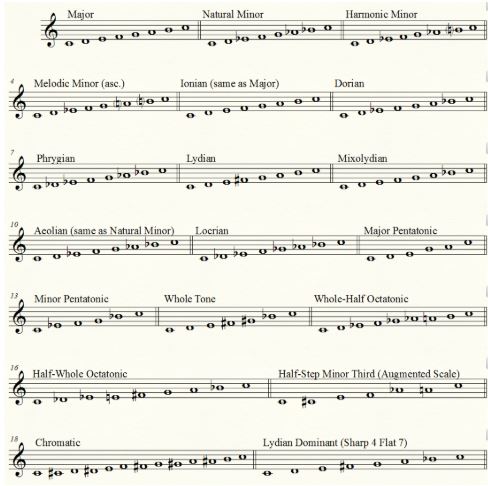Integrated Aural Skills 2018-19
Comprehensive Review of Scales
19 Possibilities…
It is not difficult to identify and notate scales, but the challenge is in sorting and categorizing our way through large amounts of information. We must now find rational methods to identify diatonic, modal, and non-diatonic scales quickly and accurately.
Diatonic Scales
Major, three types of minor, and chromatic scales are very familiar. By now, their solfege and intervallic relations are fully integrated into our aural skills consciousness.
Please review the solfege of diatonic scales by singing through the warm-up below, and listen to the Spotify playlist “UI Aural Skills III - Diatonic Style” by user “mirandawilson” to refresh your memories of this year’s study.

Modal Scales
There are two ways to think about modal scales, and you may feel free to pick the one that seems most manageable and relevant to your own meaningful musical contexts. Review the solfege below, and listen to the Spotify playlist “UI Aural Skills IV Modal Scales” by user “mirandawilson” to refresh your memory of the sounds and uses of the modes.
- First method: take do as the starting pitch

- Second method: treat them as major scales starting on different solfege

Non-Diatonic Scales
Review the characteristics, intervallic properties, and notation methods for the non-diatonic scales, and listen to the Spotify playlist “UI Aural Skills IV Non-Diatonic Scales” by user “mirandawilson” to practice listening for the particular tone qualities generated by non-diatonic harmonic systems.
- Two Pentatonic Scales
Major Pentatonic

Minor Pentatonic

- Two Hexatonic Scales
Whole Tone

Augmented (Half Step Minor Third)

- A Heptatonic Scale
Lydian Dominant

- Two Octatonic Scales
Whole-Half Octatonic

Half-Whole Octatonic

Sorting Through Information
Using this quick and effective method for sorting scales into categories, you can further refine your identification decisions and detect errors.
- First, count the tones! This is the easiest way to sort scales into categories. Remember, we are studying two types of pentatonic scale, two hexatonic, many heptatonic (major, three types of minor, modal scales, Lydian dominant), two octatonic, and one dodecatonic (i.e. the chromatic scale).
- Second, refine further using intervallic recognition to differentiate between the different scales in the category.
- Third, begin to notate your scale. Remember, some of them require exact spellings, while certain non-diatonic scales – specifically, the hexatonic and octatonic scales – can be notated using any enharmonic spelling as long as the pitch class is correct.
- Fourth, check your notation. For the diatonic scales, you may want to compare the pitches you have notated to a key signature. For non-diatonic scales, especially the hexatonic and octatonic scales, you may wish to use another method such as arpeggiation. With the hexatonic scales, you can check your notation by means of the arpeggiated augmented triad, since both of them contain two of these. With octatonic scales, check using the arpeggiated fully diminished seventh chord between alternating pitches. In all cases, be sure to check the notation of the first two pitches in the scale, since these will determine the accuracy of the arpeggiations.
All Scales, Side By Side
Lastly, here is an image of all the scales we are studying side by side. Study the scales, their intervals, and their notation. Sing through them and play them on the piano. Compare and contrast: in what respects are they similar to and different from each other?
